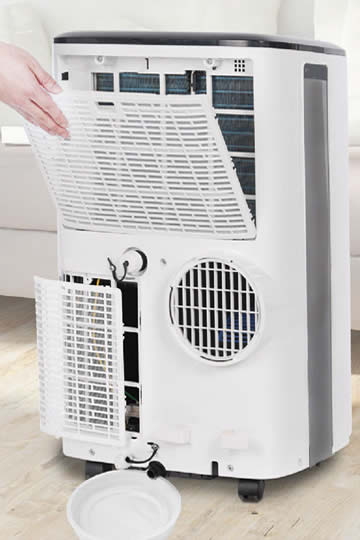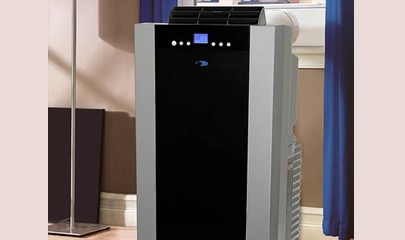What Portable Air Conditioner Does Not Need to be Drained?
Modern cooling equipment advances technologically with every passing day, so what portable air conditioner does not need to be drained so often these days?
 As summer nears, there are many people looking to upgrade their AC equipment.
As summer nears, there are many people looking to upgrade their AC equipment.
So this would be a good time to find a free standing AC that doesn't need frequent draining to avoid having that chore to do.
The problem is that most portable AC units need their water tank to be drained periodically because of the build-up of condensation that forms on the cooling coils.
However, there are a number of AC units can handle that condensation differently from the majority of models.
Automatic Moisture Management and Removal
Select air conditioner brands offer models with advanced technology that removes moisture from the air inside the unit before it condenses.
This means that there is no longer any condensed water to drip into a tank. That means you don't need to drain the water, or set up a hose to allow for continuous drainage.
These fully self-evaporating portable air conditioning units are so-called because they re-evaporate condensate and get rid of it by exhausting it through the vent pipe to the outside.
If this interests you, check out my review of one of the most highly rated examples of this genre of portable AC by clicking the "read more" link below:
Whynter ARC-14S
Eco-Friendly 14,000 BTU Dual Hose Self Evaporating Portable Air Conditioner

This model from Whynter has been a consistently popular, great value and full spec fully evaporating portable AC for several years and is still as sought after today as it was when it first appeared in stores... Click to read more
Portable Air Conditioner Draining
Frequent draining is necessary for most free standing AC models that are not self-evaporating. The amount of moisture collected depends to some extent on the humidity level.
Higher humidity means that the AC unit extracts more moisture from the air. The moisture condenses on cooling coils within the unit and drips into a tank at the base.
Some portable air conditioner brands, such as Whynter, Toyotomi, Edgestar, Avallon and Koldfront include models that make use of a condensation exhaust system to expel the water vapor that is collected during the dehumidifying/cooling process.
The vent hose is used to remove hot and moist exhaust from the unit's normal operation.
Why Portable Air Conditioners Require a Hose
An AC exhaust vent hose must be connected to run all portable air conditioners. This is so that the unit's hot, moist air can be emitted to the outdoors.
You can connect the hose from the portable AC to a window, or any other suitable outlet.
If the hose is not connected at both ends (one to the AC unit and the other to an outlet), the unit will just pump the hot, humid air back into your room, creating a net heating effect.
Although it is possible for a ventless portable AC unit to be installed in your home to increase comfort, it is important to realize that they are evaporative coolers and not true air conditioners.
What Does a Self-Evaporating AC Do?
A portable, self-evaporating air conditioner extracts moisture from air like any other type of air conditioning equipment.
However, instead of allowing condensation to form inside the unit, that moisture is re-evaporated. It then exhales the water vapor to the outside using its vent hose.
It should also be noted that these air conditioners still allow water to be stored in tanks. This is for those occasions when the unit is in dehumidifier mode.
In dehumidifier mode, much more moisture is extracted from the air than can reasonably be re-evaporated outside. So the excess is stored in the tank as it fills with water, which must then be emptied when full.
LG LP1021BSSM
10,000 BTU WiFi Portable Air Conditioner

A high powered, "smart", self evaporating portable AC, WiFi enabled and full featured, this exciting air conditioner... Click to read more
Do Window ACs Come Equipped With a Drain?
Condensation is a common phenomenon in window AC units just as it is in portable models. The condensate forms large droplets that fall to the bottom of the unit.
The small hose on the unit's outside-facing side drains the collected water directly to the outside.
A fan sling is used in older window AC units to distribute the water. Some of the water evaporates and escapes to the outside while some drips out of the unit's external drain hole.
Are Portable ACs Economically Viable?
Most free standing AC units are generally less efficient than other types of AC equipment.
This is evidenced in a lower energy efficiency (SEER) score than other types of cooler.
If you don't have central air in your home, or if window units are not allowed in your building, a portable unit may be the only way to keep cool in the summer heat.
What Portable AC Does Not Require a Vent Hose?
Without a vent hose connected up, a portable air conditioner cannot be used. You can turn it on and it will work as normal, but it will raise, not lower your room's temperature.
This advice includes smart portable air conditioners, as they operate internally the same as all other free standing AC units, just with the added functionality of remote operation via a smartphone app.
The only type of cooler that works effectively to cool a room without needing a vent hose is an evaporative cooler, also called a swamp cooler. These portable units resemble air conditioning units and are often mistakenly called ventless portable air conditioners that cool the air by evaporating moisture, but the reality is that they are not air conditioners at all.
Evaporative coolers cool the air using the evaporation of moisture principle that mimics the way your skin stays cool when you perspire. It needs a breeze to evaporate the perspiration and that transfers heat from your body to the water vapor which is carried off by the breeze leaving your skin feeling cool.
Since these coolers operate with a tank full of water that gradually empties as it is evaporated, the only time they need the tank manually emptied is at the end of the hot season when they're being put away for the winter.
Summary
While most portable AC units require their tanks to be emptied periodically, a self-evaporating AC unit is the solution to constantly emptying the water tank throughout the summer.
The inclusion of self-evaporation technology means these models are slightly more expensive than regular portable coolers. However, the extra cost represents good value when you consider how much time you can save by not having to undertake the labor intensive chore of emptying a water tank frequently.
Last Updated: June 1, 2025
![]()

